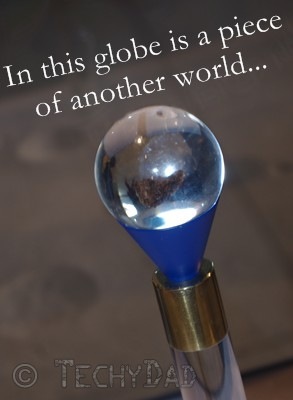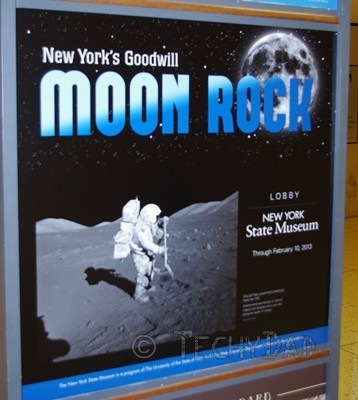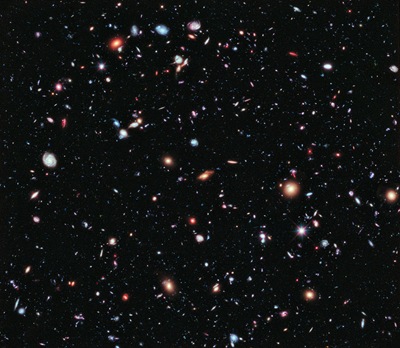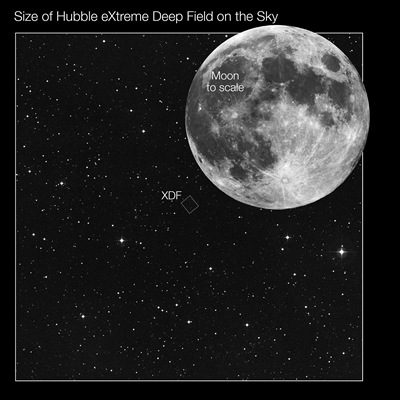Category: Science
If Science Is From Hell, Where Are Politicians From?
 A couple of days ago, I read on Slashdot that Representative Paul Broun (Georgia – R) said evolution, the Big Bang theory, and embryology are "lies straight from the pit of hell." Apparently, he believes that they are designed to lead people away from thinking that they need a savior. I’m guessing this means that he thinks that science is evil and must be stopped. (Broun seriously believes that the Earth was created as-is only 10,000 years ago. As such, any proof to the contrary must be evil. Therefore all of science is evil.)
A couple of days ago, I read on Slashdot that Representative Paul Broun (Georgia – R) said evolution, the Big Bang theory, and embryology are "lies straight from the pit of hell." Apparently, he believes that they are designed to lead people away from thinking that they need a savior. I’m guessing this means that he thinks that science is evil and must be stopped. (Broun seriously believes that the Earth was created as-is only 10,000 years ago. As such, any proof to the contrary must be evil. Therefore all of science is evil.)
This would be troubling enough (an anti-science politician), but Broun is on the House Committee on Science, Space and Technology. Yes, this guy is making decisions that affect science in this country while also saying that science comes from hell.
This is so wrong that I almost don’t know where to start. First of all, science is important to the future of our country. If we were to (magically) roll back our country to the 1800s, I doubt we’d be a leader in anything anymore. The United States would become a third world country which would be subject to the whims of other countries (like, for example, China or India) who put more emphasis on science and technology.
Our modern life is impossible without science. Computers wouldn’t function if we didn’t have a very good handle on physics. Medicine would be useless without biology and chemistry. Cell phones would be expensive paper weights without many different branches of science which contribute to building and maintaining both them and the satellite networks that make them useful.
We need representatives that will lead us into the future, not drag us back into the past. If you are on a science committee and declare that science is evil, this should be grounds to be kicked off the committee. It would be akin to a high ranking department of defense official saying we should totally disband our armed forces or a member of the SEC saying that insider trading really isn’t that big a deal.
As the image above says: The Stupid… It Burns!!!
NOTE: The "Fire Icon" in the image above comes from zeimusu via OpenClipArt.org. (I added the text to it.)
The Lonely Universe
I’m a big science fiction fan. A staple of science fiction is alien civilizations making contact with humans. Of course, we’ve yet to actually make contact or even find non-intelligent life out there. This isn’t to say that we haven’t looked. We have. We have detected planets outside of our solar system. We have even sent probes to other planets within our solar system. So why haven’t we found alien life? Perhaps it is just that the Universe is a big place.
The following is an image that the Hubble Space Telescope took of a tiny fragment of the sky.
Just how tiny? Well, this box shows the segment of the sky involved next to the moon.
That first image shows a lot of galaxies. Over 5,500, actually. In the entire Universe, there are 100 billion galaxies. Each galaxy has billions of stars. If only one hundredth of one percent had planets and only one hundredth of one percent of those had life and only one hundredth of one percent of those had intelligent life, there would be millions of intelligent life forms out there. So where are they? Why haven’t we heard any alien signals by now? Why haven’t the aliens heard our signals?
My personal theory is that time, language, and distance are the main factors. As I discussed previously, stars are very far apart from one another. We’ve only been sending signals into space that alien civilizations could detect for under 80 years. Already, we’re transitioning to technologies that might be harder for a hypothetical alien to detect. For example, we’re moving towards television transmitted via a wired Internet connection instead of via a TV tower that blasts the signal in all directions (including into space). As we do this, there will be less and less for aliens to detect.
Perhaps civilizations send out a blast of detectable signal before vanishing behind wired connections. If so, time works against us (and our hypothetical little green friends) in another fashion. When the alien signals pass us by, are we able to detect them? Perhaps the alien version of daytime TV was flooding past our planet, right there for anyone to pick up, but we were stuck in the Dark Ages. Maybe, while we were frightened of demons in the dark, proof of alien life was passing right in front of us. Possibly, a similar thing will happen with us. When old I Love Lucy broadcasts transmit past a planet with alien life, will the aliens be technologically savvy enough to detect it?
That brings us to the second point: Language. Specifically, would we recognize a signal as alien as opposed to gibberish. Suppose you didn’t understand Russian at all. If you heard five recordings, four with nonsense words and one of someone speaking Russian, it might be tough to pick out the real language. Now give that language an alien origin and see how you do. Now compress that signal using a method devised by aliens and would you even be able to tell that it wasn’t background noise?
Finally, we get to distance. Like I said earlier, there’s a huge distance between the stars. There’s an even bigger distance between galaxies. Perhaps aliens are out there all around us, but we can’t see or hear them because they are so far away. If an alien was in the Andromeda Galaxy, one of the nearest galaxies to ours, they would be over 2.5 million light years from us. This means that a message sent from them would take over 2.5 million years to reach us.
Science Fiction supposes a way to travel and communicate faster than light, but suppose science fiction is wrong. Suppose that the speed of light is the ultimate speed limit in the Universe. There could be millions of alien civilizations out there, all looking up at the stars and asking the same question: "Is anyone out there? Are we alone in the Universe?"
NOTE: The Hubble images come from here and here. Both images are free for anyone to use as are many other wonderful images from the Hubble Space Telescope.
Hands On Scientific at GE Kids Day
Amongst the animals, costumes, bounce houses, food, and other festivities, there was a booth that promised to show kids some scientific tricks. Now, this could have been a boring booth, avoided by all, but it wasn’t. The demonstrations here not only educated, but were entertaining as well. Best of all, they encouraged the kids to get involved in the experiments and were things we could pretty easily replicate at home.
First up was the tornado tube. This is a classic experiment that involves two soda bottles and colored water. One bottle is filled with water and connected to the other, empty bottle. They are turned so that the full bottle is atop the empty one. The bottles are twirled slightly and the water runs from top to bottom. As it does so, though, it forms a vortex, a tornado captured right in your own house.

(NOTE: You can’t simply hold the bottles together. You might be successful, but you’re much more likely to have a spill on your hands. There are special connector pieces that are made just for this very activity.)
After this, we moved on to another soda bottle. This one had a small amount of rubbing alcohol in it, a stopper plugging it up, and was connected to a pump. The boys were told to pump the handle a few times. When they were done, the stopper was removed. All at once, a loud popping noise was heard and the formerly clear bottle was filled with a cloudy substance. There was a cloud in the bottle!

Of course, I knew I wouldn’t be able to convey just how quick this happened using mere photos, so I shot a video of it as well.
How did this happen? Pumping air into the bottle increased the air pressure in the bottle. When the stopper was pulled, that air went rushing out. The sudden drop in air pressure lowers the temperature and the evaporated rubbing alcohol in the bottle condenses. This condensation takes the form of a smoky cloud. (To see how to perform this experiment at home, see here.)
Next up was the water surface tension and cohesion test. In this test a jar with a mesh screen is filled with water. When it is turned over the water pours out. So far, so good. However, if it is filled with water again and an index card is held over the top as it is carefully turned over, the water will remain in place when the card is removed. Yes, the water will seemingly defy gravity and stay up in the air when it seems as though it should fall.
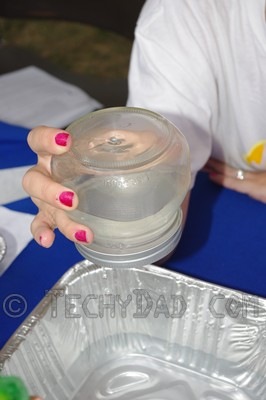
How does it do this? Water forms a membrane between the gaps in the mesh and the surface tension of this membrane keeps the water in. (Weird Science Kids has more on this experiment.)
Finally, was the color splash experiment. In this one, there were three small cups: One was filled with water, a second filled with oil and a third had water and oil. This experiment showed how density affects the behavior of liquids. A small drop of water-based food coloring was dropped in the water cup and the cup turned green. Then, a drop was placed in the oil. As expected, it sank to the bottom. It was explained that the water was denser than the oil, it weighed more and thus it sank.
But what about the third cup? In this one, a small amount of oil was floating atop some water. My boys were asked what would happen to the food coloring if it was dropped in there. NHL guessed that it would stay together. Secretly, I "knew" he was wrong and that it would sink to the water layer and then turn the water green. Guess what? I was wrong and NHL was right. NHL even guessed, when prompted, that it was due to the oil.
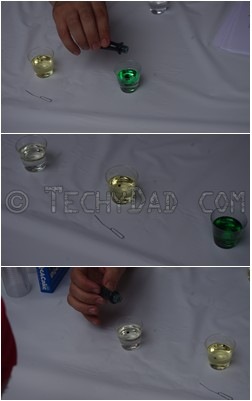
As the food coloring sank through the oil, it got itself a nice oil coating. This coating kept it from mingling with the water below. Once the food coloring blob was disturbed, though, the oil bubble popped and the color mixed into the water just as before.
All in all, my boys loved these science demonstrations and it is making me wonder what other science demos I can show the boys in my own house.
Have you ever run any cool science experiments at home for your kids? If so, what did they consist of?
Science Museum Fun
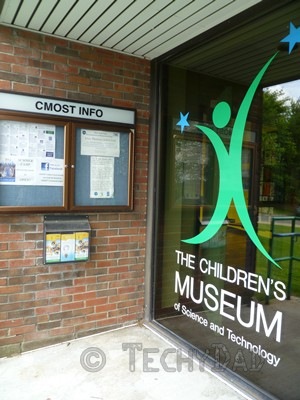 On Saturday, my parents were in town and we were trying to decide what to do with them and the boys. At first, we thought about Hoffman’s, a local amusement park, but the clouds in the sky threatened to rain (and carried through on their threat once or twice). Then, we tried to go to the New York State Museum, but there was some event going on that shut much of that area down. After finding a spot to park and regroup, we decided to go to the Children’s Museum of Science and Technology.
On Saturday, my parents were in town and we were trying to decide what to do with them and the boys. At first, we thought about Hoffman’s, a local amusement park, but the clouds in the sky threatened to rain (and carried through on their threat once or twice). Then, we tried to go to the New York State Museum, but there was some event going on that shut much of that area down. After finding a spot to park and regroup, we decided to go to the Children’s Museum of Science and Technology.
We entered, paid, and found out that a show – Astronaut – was going to begin in a minute or two. So we went there first.
When you enter the planitarium, you notice the odd seating arrangement. Except for some chairs at the back, all of the seating comes in the form of colorful mats to lay down on. These were surprisingly comfortable and afforded a great view of the screen as we looked up. Yes, the screen is on the ceiling.
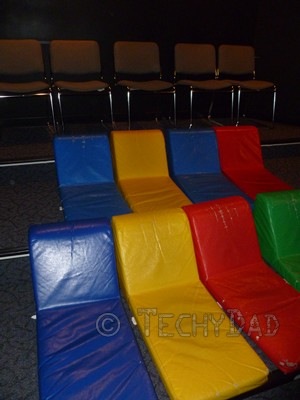
The movie was great. It detailed just what astronauts need to do to get ready to go into space and what dangers awaited them. ("Chad" better get some hazard pay after he was killed so many times!)
After the show, we wandered around the museum. Since this is a children’s museum, not only are kids allowed to touch most of the exhibits, they are encouraged to. We rotated windmills to generate power for a town. JSL touched a snake. We saw two owls. We (well, the boys and I) entered a beaver’s lodge. JSL rowed a canoe. We even made some virtual trees grow by touching a wall.
There was too much to describe everything, so instead here are a series of photos from our visit.
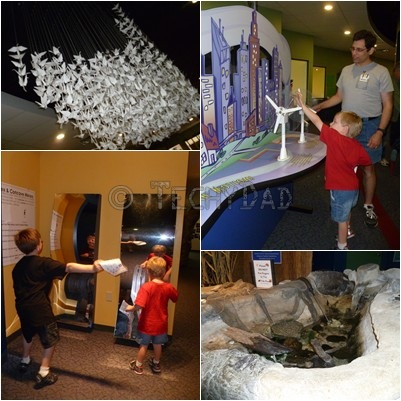
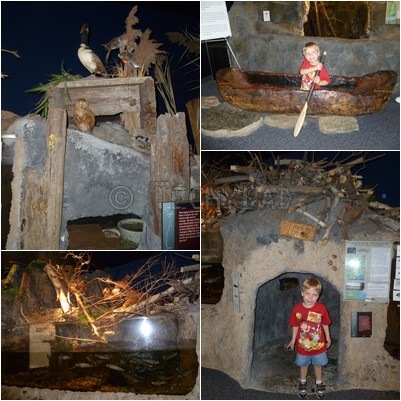
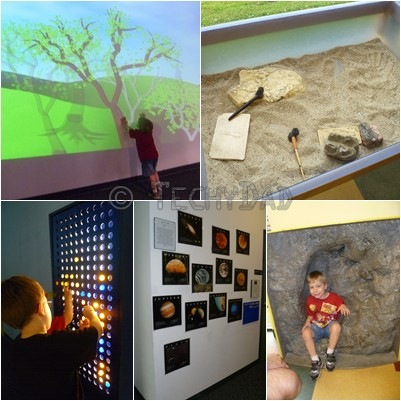
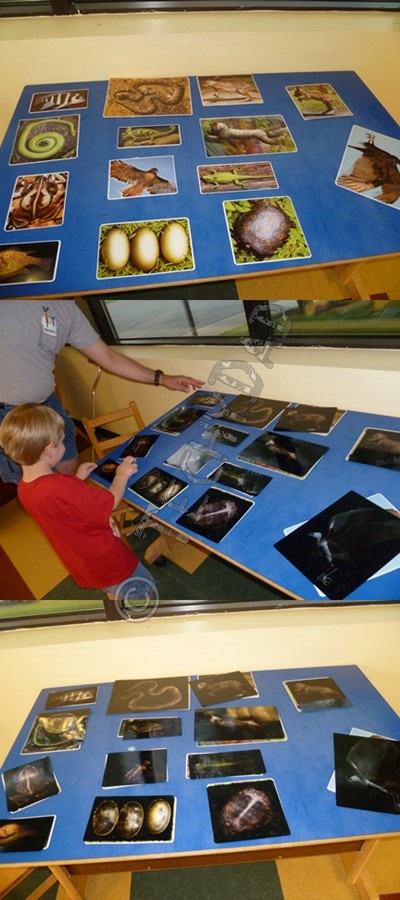
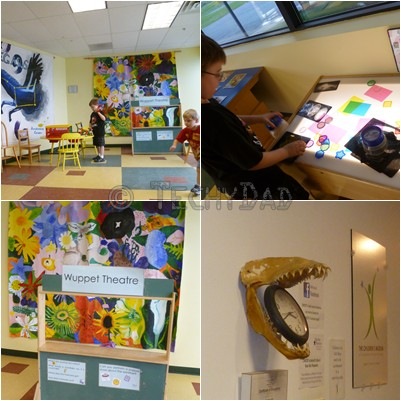
In the end, this was a fun and educational excursion. Given that it is inexpensive as well (adults and children over 2 are only $5 each and shows are an additional $1 each), I could definitely see this becoming a repeat destination.

